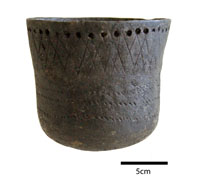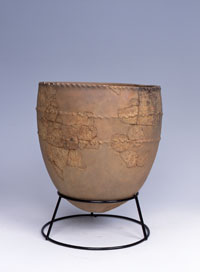Oldest pots used to cook fish

The oldest pottery in the world is found in East Asia – invented by hunter-gatherers towards the end of the last Ice Age. An international team of experts, including Prof. Peter Jordan, who became Director of the University of Groningen Arctic Centre in February, have worked out what the clay pots were used for – in most cases to prepare fish and other aquatic animals. The research was published today (11 April) on the website of the scientific journal Nature.
It has long been thought that pottery was invented by farmers from the Near and Middle East. However, pottery has been found in East Asia (China, Japan and Russia) that is between 20,000 and 12,000 years old, thousands of years before agriculture started. Within the archaeological community, there is a lot of discussion about what these pots were used for. That question could not be answered because there was simply no direct evidence. That has now changed thanks to research conducted by Peter Jordan and his colleagues from the United Kingdom, Sweden and Japan. They have analysed food traces on Japanese pot sherds up to 15,000 years old.
Fingerprint
Using gas chromatography, the composition of the fats in the traces has been analysed. The fats of fish, animals or plants all have specific characteristics resulting in a recognizable ‘fingerprint’ with this kind of analysis. The results show that most of the pots contained fish or other aquatic animals. The analysis has also revealed that the fats were heated to over 270 degrees Celsius. This makes it clear that the fat traces come from material that was cooked in the pot, and not from contamination from outside.
Stable warm climate
One important result of this research is that it further clarifies the role of pottery in human history. ‘Long before the end of the last Ice Age, people discovered how to make pottery. However, you see an explosion in the use of pottery in the early Holocene, when a stable warm climate developed’, explains Jordan. This is probably due to the adaptation of the humans to the swiftly changing climate. ‘We are the first to investigate the question why people started to use pottery by direct analysis of the food traces in very old pots, older than any that have been investigated before.’ The hunter-gatherers appear to have used pottery to profit optimally from the available aquatic animals. Jordan: ‘It perhaps served to process the seasonal surplus of food, for example salmon coming to spawn in a river.’
Innovation
Pottery was a very important technological innovation. Although this innovation was initially attributed to farmers in the Near and Middle East, we have known for some time that it first appeared among hunter-gatherers in East Asia. ‘It had become clear that the emergence of pottery was separate from the development of agriculture. And now we also know exactly what these hunter-gatherers used these very old pots for’, says Jordan. ‘These people developed a new technology that affected their way of life and their diet.’ They did that long before the emergence of agriculture, in an era when the climate was changing fast. ‘Our research reveals something of the dynamic relationship between man and his environment under this kind of circumstance.’
Note for the press
Further information: Prof. Peter Jordan
See also: ScienceLinX
Reference:
Earliest evidence for the use of pottery
O. E. Craig1, H. Saul, A. Lucquin, Y. Nishida, K. Tache, L. Clarke, A. Thompson, D. T. Altoft, J. Uchiyama, M. Ajimoto, K. Gibbs, S. Isaksson, C. P. Heron3 & P. Jordan
Nature , DOI: 10.1038/nature12109

More news
-
15 September 2025
Successful visit to the UG by Rector of Institut Teknologi Bandung
